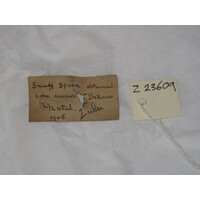Metadata
Rectangular paper labels
[ Source of title : Rachel Hand for MAA ]
Object
Textual record
Z 23609
Creative Commons License: CC BY-NC-ND https://creativecommons.org/licenses/by-nc-nd/3.0/
Accession numbers [Source - Nessa Leibhammer for FHYA, 2012, using MAA materials: Cat ID: 123232; ID NO: Z 23609]
Attributions and conjectures [Source - Nessa Leibhammer for FHYA, 2012, using MAA materials: Names: Spoon - MAA (10/12/2001) Classified: Keyword: Narcotics and Intoxicants; Tools Material: Bone; ?Pigment Descriptions: Bone snuff spoon with black incised lines - MAA (10/12/2001) Local: Maker: Cultural Group: ?Zulu Author: Date Made: Dimensions: 15.2 cm long, 1.8 cm wide, 0.4 cm high Source: Source Date: Place: Africa; Southern Africa; South Africa; Natal; Bellair - MAA (10/12/2001) Africa; Southern Africa; South Africa; KwaZuku; Natal; Bellair - Rachel Hand (29/01/2013) Period: Contexts: Original record not found. This record created from the Accession Register, which notes 'From carver nr Bellair Natal 1905'. Label accompanying object notes 'Snuff spoon obtained/ from carver Nr Bellair/ Natal/ 1905' MAA (10/12/2001) Updated: 26/07/2013 Created: 10/12/2001]
[Source - Rachel Hand for MAA, 2016: The Museum's catalogue cards and labels are part of the institution's and the objects' very history. Catalogue cards were created to add additional object information from the very first accessions back in 1884 and replacement cards were made if the original was lost, usually using both different pens and terms. Original sale or collector labels could be stuck to the cards to add biographical layers of information in the same way that letters and later photographs were sometimes attached to cards. Staff and sometimes visitors would add comments on provenances, measurements and locations over time. Reconnecting an author with their annotations can add to our knowledge of the object's history and associations. The era and author of the cards also is reflected in their physical aspects: initially details were handwritten in ink, the 1930s saw cards stamped and written on a typewriter, followed variously by handwritten details in ballpoint pen, finally moving to word-processed and laser printed texts. Like the cards the physical type of paper and pen used can suggest dates as well as authors. They can be used to confirm the identity of misplaced objects, e.g. Henry Bulwer's collection bears distinctive long, rectangular shaped paper labels and his cursive script. Early labels were handwritten in ink, on small rectangular paper or parchment label and tied through small metal reinforced holes. Others were glued directly to the object. Smaller rectangular or square paper labels, with a printed outline, usually stuck directly to the object, usually originate in late nineteenth or early twentieth century salerooms or via a collector. Larger circular, metal-edged labels were written in the museum, probably from the 1970s onwards. The 1980s bought larger labels on thick yellow paper, and remained handwritten. From c.2000, we have used acid-free yellowish paper labels, that are written on in light-sensitive and waterproof ink.]
| Event Actor | Event Type | Event Date | Event Description |
|---|---|---|---|
| Five Hundred Year Archive (FHYA) | Online curation | 2016 - | Digital image by Nessa Leibhammer |
| Museum of Archaeology and Anthropology, University of Cambridge (MAA) | Making | YYYY |
If you have difficulty accessing the objects, use these links.

Contributions